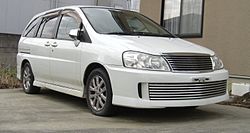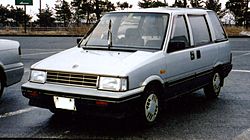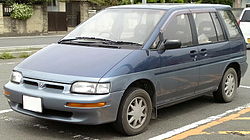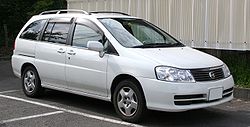- Nissan Prairie
-
Contents
Nissan Prairie 
Manufacturer Nissan Also called Nissan Multi
Nissan Stanza Wagon
Nissan Liberty
Nissan AxxessProduction 1982–2004 Predecessor none Successor Nissan Lafesta Class compact MPV The Nissan Prairie, introduced in Japan in 1981 and Europe in 1982, was a car from Japanese manufacturer Nissan. It was also known as the Multi in Canada and the Stanza Wagon in the United States. The second generation was renamed the Nissan Axxess in North America , but due to disappointing sales, was no longer offered and replaced by the larger Nissan/Ford joint venture called the Nissan Quest, and in Europe it was replaced by the Nissan Serena. When the third generation of this vehicle was introduced in Japan, it was renamed initially Prairie Liberty, with the "Prairie" name eventually dropped in November 1998. This vehicle was discontinued and replaced with the Nissan Lafesta December 2004 in Japan.
First generation (series M10 1982–1988)
Nissan Prairie 
Manufacturer Nissan Also called Nissan Multi
Nissan Stanza WagonProduction 1982–1988 Assembly Shonan, Japan Class Compact MPV Body style 5-door minivan Layout Front engine/front wheel drive, AWD Engine 2.0 L CA20E I4
2.0 L CA20S I4
1.8 L CA18S I4
1.6 L E16 I4
1.5 L E15S I4Transmission 3-speed Automatic
4-speed automatic
5-speed manualWheelbase 2WD: 99.0 in (2,515 mm)
4WD: 99.4 in (2,525 mm)Length 2WD: 170.3 in (4,326 mm)
4WD: 166.5 in (4,229 mm)Width 65.6 in (1,666 mm) Height 2WD: 62.0 in (1,575 mm)
4WD: 63.6 in (1,615 mm)Curb weight 1,020 kg (2,249 lb) Related Nissan Stanza
Nissan Violet
Nissan AusterThe Nissan Prairie, known in Canada as the Multi and the United States as the Stanza Wagon, was equipped with a choice of 5 in-line 4 cylinder engines, with either a manual or automatic transmission. Available with front wheel drive or optional four wheel drive, the vehicle had rear passenger sliding doors on both sides of the vehicle, and a folding rear seat, designed to increase the carrying capacity of the passenger compartment. The rear tailgate opened upwards as one complete unit, in a similar fashion to a hatchback or station wagon. The Prairie competed with the Toyota Sprinter Carib with a similar wagon approach, and the Honda Shuttle.
The Prairie resembled a tall station wagon / estate with the addition of sliding side doors. It was available with five seats, though seven were available. The size of one of today's compact SUVs. A contemporary competitor was the Mitsubishi Chariot — other options for cars (as opposed to minibuses / minivans) with more than five seats were large estates such as the Citroën CX family model, off-road vehicles such as the Land Rover Defender, and others such as the Talbot Matra Rancho which had extra rear-facing child seats.
The concept was inspired by the Lancia Megagamma show car from Giorgetto Giugiaro and ItalDesign, shown in 1979.
It was originally launched with a 1.5 L I4 engine and a 1.8 L engine followed later in the car's life, as did a four wheel drive version.
The first generation Prairies, while innovative, had undesirable body characteristics when driven hard, due to the missing B-pillar. The front doors and the rear sliding doors interlocked together and at the top and bottom of the respective door openings.
Second generation (series M11 1988–1998)
Nissan Prairie 
Manufacturer Nissan Also called Nissan Axxess Production 1988–1998 Assembly Shonan, Japan Successor Nissan Quest (North America)
Nissan Serena (Europe)Class Compact MPV Body style 5-door minivan Layout Front engine/front wheel drive, AWD Engine 2.4 L KA24E I4
2.0 L CA20S I4
2.0 L SR20DE I4Transmission 4-speed automatic
5-speed manualWheelbase 102.8 in (2,611 mm) Length 4.37 m (171.9 in) Width 1.69 m (66.5 in) Height 1.64 m (64.6 in) Curb weight 1,320 kg (2,910 lb) Related Nissan Stanza
Nissan Avenir
Nissan Bluebird series U14The second generation of the Prairie was introduced September 1988, and it was renamed the Nissan Axxess when sold in North America. The vehicle sold for six years (1990–95) in Canada, and in 1990 only in the United States.
The Prairie came with optional AWD but because it came with a 2.0 litre engine, it wasn't designed or equipped for vigorous off road driving. In North America, that market segment was offered an all new vehicle, called the Nissan Pathfinder. Because of the Pathfinders similar cargo carrying capacity added to an increased ground clearance and a larger 4- and V6 engine, the utility that the Prairie(Axxess) offered was seen as a lesser vehicle.
Nissan didn't retreat from the family oriented minivan market, and introduced the Nissan Quest in 1993, sharing production facilities with Ford North America, with Ford selling the Quest as the Mercury Villager. In Europe, the Prairie was replaced with the larger Nissan Serena, also originally sold in Japan in 1991.
Nissan refocused their efforts provided by the Prairie on the Japanese market, and offered additional room by stretching the back end to better accommodate third seat passengers and load carrying, calling the vehicle the Prairie Joy, which was offered August 1995. The Prairie continued to see competition from the Toyota Sprinter Carib, the Mitsubishi Chariot, and the Civic based Honda Shuttle.
Styling of the Prairie was never its strong suit, and the second generation didn't show an improvement, which hampered sales. It was popular with families who needed utility above other considerations. It was also a popular vehicle in the UK for rear-access wheelchair passenger conversions, due to long length allowing loading of a wheeled seat and stowage of folded wheelchair behind, the chassis's ability accept a lowered floor (removing the fuel tank and fitting a 30 litre tank instead), and the ability fit a rear access drop down ramp (cutting through the rear bumper and extending the hatch downwards). Some conversions also added a raised roof over the passenger space up to the rear hatch. Brotherwood made such conversions (unknown if others did so) and imported the Prairie M11 with the larger 2.4 litre KA24E engine in later years to the UK especially for conversions.
May 1997, anti-lock brakes and driver and front passenger airbags were offered, along with ultraviolet restricting tinted glass.
Third generation (series M12 1998–2004)
Nissan Prairie 
Manufacturer Nissan Also called Nissan Prairie Liberty Production 1998–2004 Assembly Shonan, Japan Successor Nissan Lafesta Class Compact MPV Body style 5-door minivan Layout Front engine/front wheel drive, AWD Engine 2.0 L SR20DE I4
2.0 L SR20DET I4 turbo
2.0 L QR20DE I4Transmission 4-speed automatic
CVTWheelbase 2,690 mm (106 in) Length 4,575 mm (180.1 in) Width 1,695 mm (66.7 in) Height 1,690 mm (67 in) Curb weight 1,630 kg (3,600 lb) Related Nissan Altima
Nissan AvenirThe Nissan Liberty is the new name for the Nissan Prairie minivan in 1999. It has rear sliding doors and is available with either front wheel drive or all wheel drive. It is equipped with either the SR20DE or the SR20DET engine, both of which are mated to either a 4-speed automatic or a CVT transmission.
The third generation Prairie now shared a platform with the compact station wagon Nissan Avenir with the Prairie/Liberty focused more on flexible seating and cargo carrying duties.
Some of the issues buyers had with the Prairie was its appearance and performance, so the styling was given more attention, and Nissan's Autech division punched up its performance image, by offering the Liberty Rider that replaced the Axis trim package. The turbocharged engine was offered in the "Highway Star 4WD" package October 12, 1999, as well as the "Highway Star GT4", also enhanced by Autech. Front wheel drive vehicles were only available with the CVT transmission. Styling and luxury items offered on the larger Nissan Elgrand were also offered on the Liberty.
The Liberty saw competition from Toyota and Honda during this generation from the Toyota Ipsum, Mitsubishi Chariot, and the Honda Stream, and a related siblings called the Nissan Bassara and the Nissan R'nessa.
June 19, 2001 Nissan offered a rear door that swung up electrically, with a platform that extended out for passengers that used a wheelchair, and by remote control. The sliding doors were offered with an electrically opening feature on both sides May 7, 2001. Various appearance packages were offered to update the appearance until the vehicle was cancelled December 2004, and replaced by the all new Nissan Lafesta.
References
- Archives Catalog WEB Liberty (M12-period)
- WEB Liberty Archives Catalog (M12-medium term)
- Archives Catalog WEB Liberty (M12-late)
- Liberty / CM PRAIRIELIBERTY information
Nissan Motor Company Vehicles Current370Z • Advan • Altima • Aprio • Armada • Atlas • Bluebird • Bluebird Sylphy • Cabstar • Caravan • Civilian • Clipper • Cube • Dualis • Elgrand • Frontier • Freeson • Fuga • GT-R • Juke • Lafesta • Leaf • Livina Geniss • Maxima • March • Murano • Moco • Navara • Note • NV200 • NV400 • Otti • Paladin • Pathfinder • Patrol • Qashqai • Quest • Rogue • Safari • Sentra • Serena • Skyline • Teana • Tiida • Titan • Urvan • Versa • Wingroad • X-Trail • XterraPastDC-3 • 100NX • 1200 • 310 • 180SX • 200SX • B-210 • 240SX • 240Z • 280ZX • 300C • 300ZX • 350Z • 510 • 810 • Almera • Almera Tino • Altra (EV) • Avenir • Auster • Bassara • Be-1 • Caball • Cablight • Cedric • Cefiro • Cherry • Cima • Crew • Datsun Truck • Echo • Expert • Fairlady • Figaro • Gazelle • Gloria • Hardbody Truck • Hypermini • Homy • Interstar • Junior • Largo • Laurel • Leopard • Liberty • Mistral • Multi • NX • Pao • Pintara • Pino • Platina • Prairie • Presage • Presea • Primera • President • Pulsar • Pulsar GTI-R • R390 GT1 • R'nessa • Rasheen • Roadster-Road Star • S-Cargo • Saurus • Saurus Jr • Silvia • Sileighty • Skyline GT-R • Stanza • Stagea • Sunny • Terrano • Terrano II • Vanette • VioletConcept126X • 216X • 270X • 300 Bambu • 315-a • AA-X • Actic • AD-1 • AD-2 • AL-X • Alpha T • Amenio • AQ-X • AP-X • ARC-X • AXY • AZEAL • Bevel • Boga • C-Note • Chapeau • Chappo • Cocoon • CQ-X • Crossbow • CUE-X • Cypact • Duad • Dunehawk • Effis • ESV • Evalia • EV Guide II • EV Truck • FEV • FEV-II • Foria • Forum • Fusion • Gobi • GR-1 • GR-2 • GT-R • ideo • Intima • Jikoo • Judo • Jura • Kino • KYXX • Land Glider • LEAF • LUC-2 • MID4 • Mixim • mm.e • Moco • Nails • NCS • NEO-X • NRV-II • NX-21 • NV2500 • Pivo • Pivo 2 • Qazana • Redigo • Round Box • Serenity • Sport Concept • Stylish VI • Terranaut • Tone • Townpod • Trailrunner • TRI-X • URGE • UV-X • XIX • XVL • Yanya • ZarootEngines GRX-3 • UD12 • VRT35Marques Nissan • InfinitiSubsidiaries
and divisionsSee also ATTESA • Datsun • HICAS • Prince • Renault-Nissan Alliance • Nissan Shatai • UD Nissan Diesel • VVL • VVEL • dCi
 Category ·
Category ·  Commons
CommonsType 1980s 1990s 2000s 2010s Model year 0 1 2 3 4 5 6 7 8 9 0 1 2 3 4 5 6 7 8 9 0 1 2 3 4 5 6 7 8 9 0 1 2 Compact crossover Rogue Mid-size crossover Murano Murano Mini SUV Juke Compact SUV Xterra Xterra X-Trail Mid-size SUV Pathfinder Pathfinder Pathfinder Full-size SUV Armada Mini MPV Cube Compact MPV Stanza Wagon/Multi Axxess Minivan Vanette Quest Quest Quest Quest Van NV Pickup Datsun Truck Hardbody Truck Frontier Frontier Titan Categories:- Nissan vehicles
- All wheel drive vehicles
- Front wheel drive vehicles
- Minivans
- Compact MPVs
- Vehicles with CVT transmission
- Vehicles introduced in 1981
- 1990s automobiles
- 2000s automobiles
Wikimedia Foundation. 2010.





